Join More Than 50,000+ Subscribers and get latest camera news and rumors
NEW CAMERA VIDEOS ON YOUTUBE
|
By admin, on February 16th, 2012
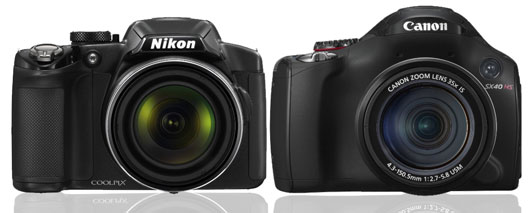
Nikon P510 vs. Canon SX40 HS specification comparison review, read the review before buying you next Super Megazoom Camera.
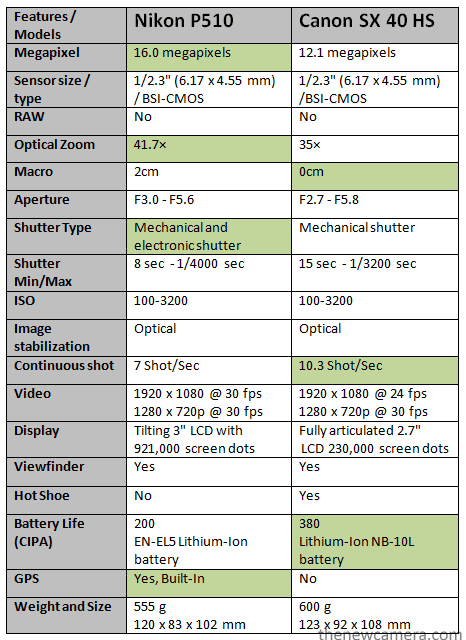
Optical Zoom and Lens Quality
Nikon features 41.7x optical zoom, Canon SX 40 HS limited to 35x only.
Canon features UD glass, double-sided aspherical glass-molded and ultra-high-refraction-index glass lens elements to effectively suppress chromatic aberration. The camera uses a VCM (Voice Coil Motor) for high-speed, quiet, energy-efficient lens movement with precise control.
Nikon P510 comes with Four ED glass elements minimize chromatic aberration.
Sensor: Nikon uses 16 Mp BSI CMOS sensor and Canon uses 12.1 Mp BSI CMOS sensor.
Canon SX 40 HS uses newly developed BSI CMOS sensor and DIGIC 5 image processor, the Canon SX40 HS also features advanced Multi-area White Balance optimizing color tones of both subject and background under multiple light sources.
Nikon P510 uses new Back-illuminated 16-MP CMOS sensor, you get more resolution than the Canon SX 40 HS.
Image Processor: Nikon P510 uses old Expeed 2 image processor, Canon uses new DIGIC V image processor.
Image processor of Canon is very fast, It can capture/process approx 10.3 shot/sec in high speed shooting mode, Nikon P500 is limited to 8 shot/sec only.
Image Stabilization: Both Canon SX 40 HS and Nikon P510 features optical Image Stabilization.
Canon SX 40HS features Hybrid IS System of Canon SX 40 HS features Six Intelligent IS Modes, Canon SX 40 HS automatically chooses from six different modes (Normal, Macro, Panning, Dynamic, Powered, Tripod) to optimize image stabilization and help achieve crisp, blur-free images for various shooting conditions.
Nikon P510 features second generation vibration reduction system to combat camera shake.
Shutter: Nikon P510 uses Mechanical and electronic shutter, canon uses Mechanical only.
Nikon P510 comes with Mechanical and electronic shutter, you get Maximum shutter speed up to 1/4000, Canon comes with Mechanical shutter and the speed is limited to 1/3200. The Min shutter speed of Canon is 15 sec and Nikon is 8 sec only.
Movie Mode: Both Nikon and Canon offers Full HD Video recording and AF during Video mode.
GPS: Nikon P510 comes with Built-In GPS, Canon SX 40 HS have no GPS.
Display: Practically I like Canon vari-angle display, but Nikon Wins here, Nikon P510 features 3″ Tilting Screen with 921,000 screen dots and Canon comes with fully articulated 2.7″ LCD with 230,000 Screen dots.
Battery Life: Canon SX40 HS battery life is approx double than the Nikon P510.
Overall Conclusion:
Buy Nikon P510 if you want to have Super Megazoom Camera (42X optical zoom), more resolution(16Mp sensor), better display and In-Built GPS.
Buy Canon SX40 HS if you want better IS system, fast image processor (with less noise), bright (F2.7) lens, High speed burst mode (10.3 fps) and longer battery life.
Buy Nikon P510 from – Amazom || B&H || Adorama
Buy Canon SX 40 HS from: Amazon || Amazon UK || Adorama || B&H
By admin, on January 20th, 2012
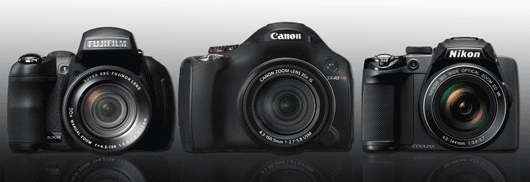
Fujifilm HS30 vs. Canon SX40 HS vs. Nikon P500 specification comparison review, read the review below and select your best megazoom camera.
Buy Fujifilm HS30 from Amazon
Buy Canon SX40 HS from Amazon
Buy Nikon P500 from Amazon
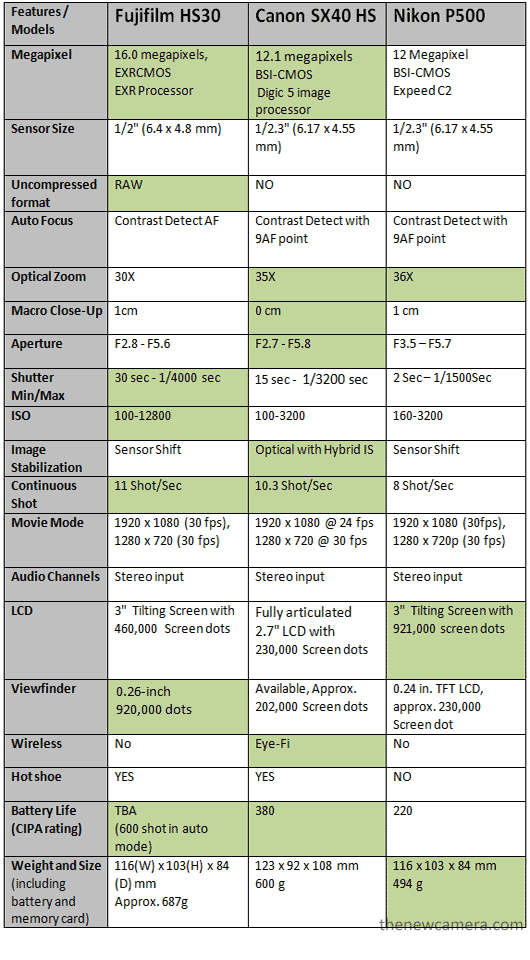
Sensor and image processor:
Fujifilm claims that HS30 uses new sensor, by redesigning the shape of the photo diodes used in the EXR-CMOS sensor, the images display 30% less digital noise at higher ISO settings (compared to HS20 @ ISO 3200), which results in smoother tones and better low light images.
Canon SX 40 HS uses newly developed BSI CMOS sensor and DIGIC 5 image processor, the Digic 5 image processor creates 75% less noise and 6X faster compared to Digic 4 image processor, Due to new sensor and image processor you get more details and less noise in high ISO settings.
Multi-area White Balance in SX 40 HS: The Canon SX40 HS features advanced Multi-area White Balance optimizing color tones of both subject and background under multiple light sources.
Nikon P500 comes with a BSI CMOS sensor but uses old expeed 2 image processor.
Image Processor: Image processor of both Canon and Fuji are very fast, both can capture approx 10.3 / 11 shot/sec in high speed shooting mode, Nikon P500 is limited to 8 shot/sec only.
RAW: Fuji is a clear winner on RAW mode, Only Fujifilm HS30 features RAW format capture.
IS Image Stabilization
| |
Fujifilm HS30 EXR |
Canon SX 40 HS |
Nikon P500 |
| Image Stabilization |
Sensor Shift + High ISO |
Optical |
Sensor Shift and VR |
| IS Modes(Hybrid IS) |
Not Available |
Available (Normal, Macro, Panning, Dynamic, Powered, Tripod) |
Not Available |
Fuji (CMOS shift + High ISO) Fuji HS30 uses sensor shift and High ISO modes to prevent camera shake.
Canon SX 40HS features 6 IS Modes and Optical IS The new Hybrid System of Canon SX 40 HS features Six Intelligent IS Modes, Canon SX 40 HS automatically chooses from six different modes (Normal, Macro, Panning, Dynamic, Powered, Tripod) to optimize image stabilization and help achieve crisp, blur-free images for various shooting conditions
Nikon features Image sensor shift(not optical) + electronic vibration reduction (VR) function
Images captured with image sensor shift vibration reduction enabled are further processed with electronic VR for images that are sharper and exhibit less blur.
Lens and Aperture Range
| Camera / Specification |
Fujifilm HS30 EXR |
Canon SX 40 HS |
Nikon P500 |
| Optical Zoom |
30X |
35X |
36X |
| Macro |
1cm |
0 cm |
1 cm |
| Aperture |
F2.8 – F5.6 |
F2.7 – F5.8 |
F3.5 – F5.7 |
Based on lens quality, aperture and optical zoom range canon SX 40 HS is a clear winner,
Canon features UD glass, double-sided aspherical glass-molded and ultra-high-refraction-index glass lens elements to effectively suppress chromatic aberration while maintaining a remarkably compact size. The camera uses a VCM (Voice Coil Motor) for high-speed, quiet, energy-efficient lens movement with precise control.
Similarly as canon, Fuji features high optical performance glass lens elements (aspherical, high refractive index, and ED glass lenses) make the exceptional brightness of F2.8 at wide angle and F5.6 at telephoto possible.
Nikon P500 features 36x Zoom and NIKKOR ED glass.
Shutter Speed
You get more range in shutter speed in Fujifilm HS30 compared to SX 40 HS or Nikon P500.
| Shutter Speed |
Fujifilm HS30 EXR |
Canon SX 40 HS |
Nikon P500 |
| Max |
4000 Sec |
3200 Sec |
1/1500 Sec |
| Min |
30 Sec |
15 Sec |
2 Sec |
| Continuous Shot |
11 Shot/Sec |
10.3 Shot/Sec |
8 Shot/Sec |
Movie Mode
All the three Megazoom camera offers Full HD Video recording and AF during Video mode. Fuji offers Full HD at 30 fps, Canon Full HS at 24 fps and Nikon Full HD at 30 fps.
Display:
Practically I like Canon vari-angle display, but Nikon Wins here, Nikon P500 features 3″ Tilting Screen with 921,000 screen dots and Fully articulated 2.7″ LCD with 230,000 Screen dots.
Viewfinder:
Fuji features a 0.26-inch superb high resolution viewfinder (approx. 920,000 screen dots) with eye sensor.
Batter Life
No CIPA rating currently available for Fuji HS30, but Fuji claims you can take 600 shots at auto with the new Lithium-ion rechargeable battery, Canon SX 40HS CIPA rating is 380 and Nikon P500 CIPA rating is 220.
Price
| Camera Models |
Fujifilm HS30 EXR |
Canon SX 40 HS |
Nikon P500 |
| Price (List Price) |
$499 |
$399 |
$320 |
Overall Conclusion: Nikon P500 is the most affordable megazoom camera, however according to specification, both canon and Fuji are better than the Nikon P500, Fuji HS30 zoom lens is limited to 30X but features RAW format and ISO range up to 12800, whereas canon SX 40 HS features 35X Zoom Lens with excellent optics and Hybrid IS.
Buy Fujifilm HS30 from Amazon
Buy Canon SX40 HS from Amazon
Buy Nikon P500 from Amazon
Support New Camera Buy Music CD or Digital Camera at amazon it helps this site, and you do not pay anything extra, it is just a way to help support this site.

By admin, on November 29th, 2011
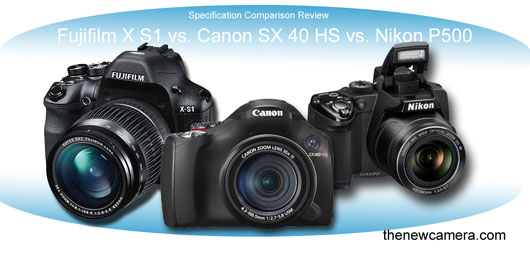
Fujifilm X S1 features bigger sensor but comes at high price with limited 26X optical Zoom Lens on the other hand Canon SX 40 HS comes half price and features 35X optical Zoom, which camera you will buy and why? Read the Specification Comparison review of Fujifilm X S1 with Canon SX40 HS and Nikon P500 and share your thoughts with us.
Buy Fujifilm X S1 from Amazon || Amazon UK
Buy Canon SX 40 HS from Amazon || Amazon UK || Adorama || B&H
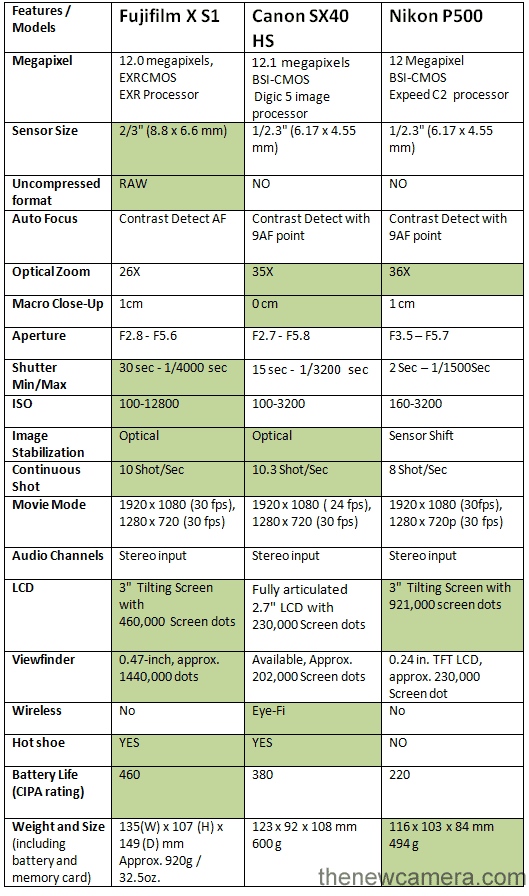
About Sensor and processor
Fujifilm X S1 features bigger sensor compared to Canon SX 40HS and Nikon P500, The sensor is not only bigger but Fuji X S1 uses same sensor of Fuji X 10 (Pro compact camera) and in several test done by Fujifilm and others we found that Fuji X 10 sensor is better compared to Canon G12.
The new sensor of fuji X S1 allows you Capture 3 exposures of the same scene with high-speed continuous shooting, each at a different dynamic range setting (100%, 200% and 400%).
But we should not forget about canon SX 40 HS Sensor and image processor, Canon SX 40 HS uses newly developed BSI CMOS sensor and DIGIC 5 image processor, the Digic 5 image processor creates 75% less noise and 6X faster compared to Digic 4 image processor, Due to new sensor and image processor you get more details and less noise in high ISO settings.
Multi-area White Balance in SX 40 HS: The Canon SX40 HS features advanced Multi-area White Balance optimizing color tones of both subject and background under multiple light sources.
Nikon P500 image sensor captures more noise and less details compared to Canon SX 40 HS (See here).
Image Processor: Image processor of both Canon and Fuji are very fast, both can capture 10 shot/sec in high speed shooting mode, Nikon P500 is limited to 8 shot/sec only.
RAW: Only Fujifilm X S1 features RAW format capture, Fujifilm X S1 features in camera RAW converter, The conversion of RAW data not only takes into account exposure compensation, white balance and other in-camera image quality control settings, but also lets the user apply Film Simulation modes in the converter mode. For PC you get
AF Points: Fuji not mentioned in its specification chart but during research we found that Fujifilm X S1 features 49 selectable AF points, Canon and Nikon Features 9 AF points.
IS Image Stabilization
| |
Fujifilm |
Canon SX 40 HS |
Nikon P500 |
| Image Stabilization |
Optical |
Optical |
Sensor Shift and VR |
| IS Modes(Hybrid IS) |
Not Available |
Available (Normal, Macro, Panning, Dynamic, Powered, Tripod) |
Not Available |
Fuji Claims Fujifilm X S1 Equipped with a newly developed image stabilization mechanism, X-S1 effectively compensates for camera shake even when you press the shutter to capture a subject at extreme zoom. No further details available about the IS system of X S1.
Canon SX 40HS features 6 IS Modes and Optical IS The new Hybrid System of Canon SX 40 HS features Six Intelligent IS Modes, Canon SX 40 HS automatically chooses from six different modes (Normal, Macro, Panning, Dynamic, Powered, Tripod) to optimize image stabilization and help achieve crisp, blur-free images for various shooting conditions
Nikon features Image sensor shift(not optical) + electronic vibration reduction (VR) function. Images captured with image sensor shift vibration reduction enabled are further processed with electronic VR for images that are sharper and exhibit less blur.
Lens and Aperture Range
| Camera / Specification |
Fujifilm X S1 |
Canon SX 40 HS |
Nikon P500 |
| Optical Zoom |
26X |
35X |
36X |
| Macro |
1cm |
0 cm |
1 cm |
| Aperture |
F2.8 – F5.6 |
F2.7 – F5.8 |
F3.5 – F5.7 |
Based on lens quality, aperture and optical zoom range canon SX 40 HS is a clear winner, Fujifilm Zoom lens is limited to 26X only.
Canon features UD glass, double-sided aspherical glass-molded and ultra-high-refraction-index glass lens elements to effectively suppress chromatic aberration while maintaining a remarkably compact size. The camera uses a VCM (Voice Coil Motor) for high-speed, quiet, energy-efficient lens movement with precise control.
Similarly as canon, Fuji features high optical performance glass lens elements (aspherical, high refractive index, and ED glass lenses) make the exceptional brightness of F2.8 at wide angle and F5.6 at telephoto possible.
Nikon P500 features 36x Zoom and NIKKOR ED glass.
Shutter Speed
You get more range in shutter speed in Fujifilm X S1 compared to SX 40 HS or Nikon P500.
| Shutter Speed |
Fujifilm X S1 |
Canon SX 40 HS |
Nikon P500 |
| Max |
4000 Sec |
3200 Sec |
1/1500 Sec |
| Min |
30 Sec |
15 Sec |
2 Sec |
| Continuous Shot |
10 Shot/Sec |
10.3 Shot/Sec |
8 Shot/Sec |
Movie Mode
All the three Megazoom camera offers Full HD Video recording and AF during Video mode. Fuji offers Full HD at 30 fps, Canon Full HS at 24 fps and Nikon Full HD at 30 fps.
Display: Practically I like Canon vari-angle display, but Nikon Wins here, Nikon P500 features 3″ Tilting Screen with 921,000 screen dots and Fully articulated 2.7″ LCD with 230,000 Screen dots.
Viewfinder: Fuji is a clear winner, it features a 0.47-inch superb high resolution viewfinder (approx. 1440,000 screen dots) with eye sensor.
Batter Life: Based on CIPA rating the Fujifilm X S1 battery life is better compared to Canon SX40 HS and Nikon P500.
Size and Weight: Nikon wins here, The Fuji weight and Size is similar to entry level DSLRs, Fuji weight (Max) 920g and have bigger body Compared to Canon and Nikon.
Price
| Camera Models |
Fujifilm X S1 |
Canon SX 40 HS |
Nikon P500 |
| Price (List Price) |
$800 |
$429 |
$399 |
The Price of Fujifilm is just double the price of current Megazoom camera, will you pay double price for a bit bigger sensor or you will buy Canon or nikon?
Overall Conclusion
Best Megazoom: If you want a MegaZoom Camera Canon SX40 HS is a clear winner, canon SX 40 HS 35X Zoom Lens features excellent optics with Hybrid IS, Fujifilm X S1 is limited to 26X only.
Buy Fujifilm X S1 from Amazon || Amazon UK
Buy Canon SX 40 HS from Amazon || Amazon UK || Adorama || B&H
Image quality and dynamic range: Fujifilm X S1 Wins here, The X S1 uses same sensor as pro compact camera X10, you get RAW file, more control over the dynamic range while shooting.
Fujifilm X S1 Available from Feb at Amazon and other stores
By admin, on October 30th, 2011
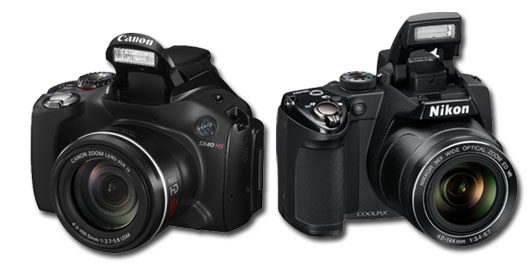 Canon SX 40 HS vs Nikon P500, See our super zoom camera comparison review below. Canon SX 40 HS vs Nikon P500, See our super zoom camera comparison review below.
Buy Canon SX 40 HS from Amazon | Amazon UK | Adorama
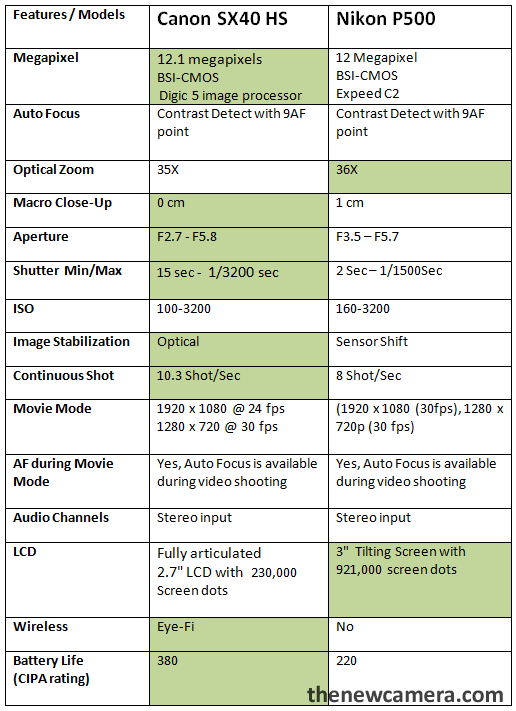
About Sensor and processor: Canon SX 40 HS uses newly developed BSI CMOS sensor and DIGIC 5 image processor, the Digic 5 image processor creates 75% less noise and 6X faster compared to Digic 4 image processor, Due to new sensor and image processor you get more details and less noise in high ISO settings.
The new image processor also features advanced Multi-area White Balance optimizing color tones of both subject and background under multiple light sources.
Image Quality: We have seen many high ISO sample from both the camera, , even at ISO 800 and 1600 Canon SX 40 HS images have less noise, better color and sharpness compared to Nikon P500.
IS Image Stabilization
| |
Canon SX 40 HS |
Nikon P500 |
| Image Stabilization |
Optical |
Sensor Shift and VR |
| IS Modes |
Available (Normal, Macro, Panning, Dynamic, Powered, Tripod) |
Not Available |
Canon SX 40 HS features better image stabilization compared to Nikon P500.
Canon SX 40HS features 6 IS Modes and Optical IS One of the most important innovations for a point-and-shoot camera has been Image Stabilization (IS) since it helps improve image quality by reducing camera blur for both images and videos. Canon has taken this technology one step further with the new Intelligent IS which automatically chooses from six different modes (Normal, Macro, Panning, Dynamic, Powered, Tripod) to optimize image stabilization and help achieve crisp, blur-free images for various shooting conditions
Nikon features Image sensor shift(not optical) + electronic vibration reduction (VR) function, images captured with image sensor shift vibration reduction enabled are further processed with electronic VR for images that are sharper and exhibit less blur.
Lens and Aperture Range
| Camera / Specification |
Canon SX 40 HS |
Nikon P500 |
| Optical Zoom |
35X |
36X |
| Macro |
0 cm |
1 cm |
| Aperture |
F2.7 – F5.8 |
F3.5 – F5.7 |
You get better lens, Aperture range and Macro mode in Canon SX 40 HS, Nikon P500 features 1X more Zoom Compared Canon SX 40 HS.
The Canon SX 40 HS features 35X optical zoom and the advanced design employs UD glass, double-sided aspherical glass-molded and ultra-high-refraction-index glass lens elements to effectively suppress chromatic aberration while maintaining a remarkably compact size. The camera uses a VCM (Voice Coil Motor) for high-speed, quiet, energy-efficient lens movement with precise control.
Nikon P500 features 36x Zoom and NIKKOR ED glass.
Shutter Speed: You get more range in shutter speed and faster burst rate in SX 40 HS, the Canon SX 40HS is better compared to Nikon P500
| Shutter Speed |
Canon SX 40 HS |
Nikon P500 |
| Max |
3200 Sec |
1/1500 Sec |
| Min |
15 Sec |
2 Sec |
| Continuous Shot |
10.3 Shot/Sec |
8 Shot/Sec |
High Speed Shooting: An added benefit of the DIGIC 5 image processor is the incorporation of the new High-speed Burst HQ providing users with the ability to continuously capture a maximum of 10 frames.
Movie Mode: Both features Full HD recording and AF during movie mode, at Canon you get 24 fps at Full HD and at Nikon your get 30 fps at Full HD, Nikon is a bit better.
Display: Nikon Wins here, Nikon P500 features 3″ Tilting Screen with 921,000 screen dots and Fully articulated 2.7″ LCD with 230,000 Screen dots.
Batter Life and other: Based on CIPA rating the Canon SX 40 HS battery life is better compared to Nikon P500. The Canon SX 40 HS supports Eye-Fi and weights 100gm(approx) more than Nikon P500.
Overall Conclusion: The Overall performance of SX 40HS is better compared to Nikon P500. Canon SX 40 HS is a clear winner.
Buy Canon SX 40 HS from Amazon | Amazon UK | Adorama
By admin, on October 29th, 2011
Many users and visitors of new camera asking about the Canon SX 40 HS image quality, they want to know which camera is more better and why? You can also jump to Specification review (Canon SX 40HS vs Nikon P500) but before that I want to answer one question…
The most asked question: Both Nikon P500 and Canon SX 40 HS features 12 megapixel BSI CMOS sensor, which one is more better and why?
Answer: The Canon SX 40 HS is more better compared to Nikon P500 in High ISO test.
See the image below. The Left side image(s) taken from Canon SX 40 HS have less noise, more sharper and have better color
Buy Canon SX 40 HS from Amazon
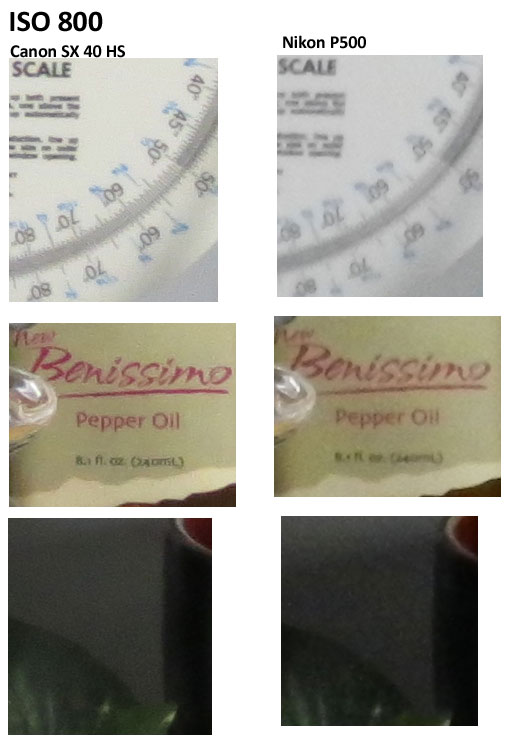 Image Copyright - Imagine Resource
Image Credit: imaging-resource.com
Canon SX 40 HS HIGH ISO Sample at Digital camera Info
Nikon P500 HIGH ISO Samples at Cnet
By admin, on October 4th, 2011
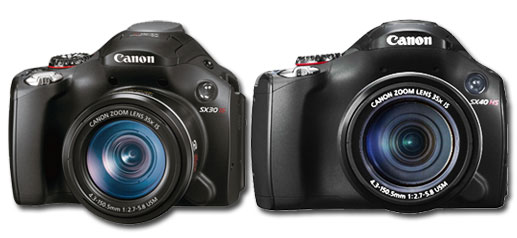
Buy Canon SX40 HS from Amazon || Buy Canon SX 40 HS from Amazon UK
Canon SX40 HS vs Canon SX30 IS, Which camera you should buy Canon SX40 HS or Canon SX30 IS, see the comparison review below and select your nest mega zoom camera.
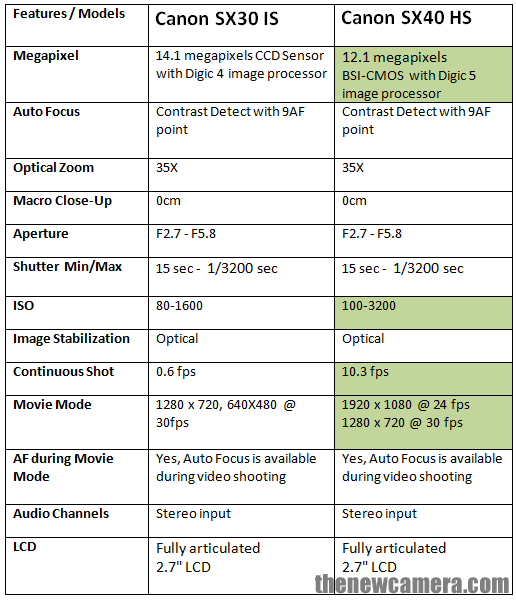
So What changed and What hasn’t changed form Canon SX30 IS to Canon SX40HS?
What hasn’t Changed?
The new canon SX40 HS Zoom Lens, The SX40 HS 35X zoom lens is same as canon SX30 IS, shutter speed and Display unit are same.
What Changed?
NEW Sensor: 12.1 Megapixel BSI CMOS Sensor, the new sensor features improved lowlight performance and true life colors.
The New Image processor Digic V: The New image processor features increase in processing speed and power. Improved chip architecture and algorithms, you get more clear and sharp images with true life color.
New fetures in Digic V processor
Hybrid white balance system: DIGIC 5 Image Processor also makes possible a new, highly advanced automatic white balance system. Whereas conventional white balance makes an overall adjustment based on a single type of light source, the new Canon Multi-Area White Balance analyzes several areas of the image to determine whether different adjustments are needed, for example, for the main subject and the background.
New Intelligent IS (Image Stabilization technology): Intelligent IS analyzes camera movement and applies the best shake correction method for the shooting situation. For stills, the system automatically selects among Normal, Panning, Macro (Hybrid) and Tripod IS modes. When shooting video, the system automatically selects among Dynamic, Powered, Macro and Tripod IS modes.
Improved ISO Range: The low light performance is improved in Canon SX40 HS, the new sensor features ISO range from 100 to 3200.
Continuous Shot: Canon SX40 HS features 10.3fps of continuous shooting.
Full HD Video Recording: Canon SX40 HS captures Full HD Video 1920 x 1080 @ 24 fps and HD Videos 1280 x 720 @ 30 fps, it also support Auto-Focus during movie mode.
Conclusion: Canon SX40 HS is better than the Canon SX 30 IS
Should you Upgrade from Canon SX 30 IS – I would say yes, you get better low light performance, better IS, 10.3fps of Continuous shooting mode and Full HD Video Recording.
Buy Canon SX40 HS from Amazon || Buy Canon SX 40 HS from Amazon UK
Support New Camera Buy Music CD or Digital Camera at amazon it helps this site, and you do not pay anything extra, it is just a way to help support this site.

By admin, on September 16th, 2011
New Canon SX40 HS camera is now available at amazon, we will add more Canon SX40 HS sample images as soon as we get it,

See SX40 HS sample images at canon-europe.com
|
KEEP THIS BLOG ALIVE - Support New Camera Buy Canon Lenses, Buy Music CD or Digital Camera at amazon it helps this site, and you do not pay anything extra, it is just a way to help support this site.

|







 Canon SX 40 HS vs Nikon P500, See our super zoom camera comparison review below.
Canon SX 40 HS vs Nikon P500, See our super zoom camera comparison review below.








